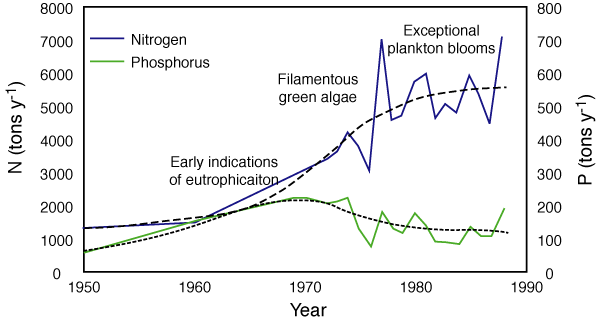


 |  |  | 17.3 Phases |
We distinguish between three principle, consecutive phases: (A) Enrichment phase, (B) initial and secondary effects and (C) extreme and ultimate effects (Figure 5). During the enrichment phase increases in pelagic and benthic biomass, fish and mussel yields are recorded. There are several lines of evidence that moderate eutrophication can result in increases in harvestable production and resources attractive to humans. Thus moderate eutrophication can be considered beneficial if increased harvest of fish and shellfish is the focus of our attention. In each ecosystem, there is a level of nutrient availability over which no increase in harvestable resources takes place. This is by definition the end of the enrichment phase. `Points of no return' (beyond these the ecosystem does not return to its original state after a driver such as nutrient supply is reduced) lay somewhere between B and C.

When the enrichment phase comes to an end the initial and secondary effects of eutrophication become visible. There exists an entire range of phenomena and processes that are characteristic for the second phase of eutrophication. We can observe changes in species composition, e.g. certain benthic algae disappear or certain polychaets domiante. Similar processes can be observed for phytoplankton species. In the Southern North Sea extensive blooms of Phaeocystis globosa reflect eutrophication. Further, the increase in relative contribution of flagellates to the phytoplankton biomass is interpreted as a sign of eutrophication, reflecting increased N and P supply while that of Si declines, mainly due to dam constructions. Reduction in light penetration caused by increased bloom density and turbidity decrease the depth of the euphotic zone and reduces the area where benthic algae prosper. The increasing frequency of hypoxic episodes belongs also to the initial and secondary effects of eutrophication.
The phase of extreme and ultimate effects is characterised by the large-scale disappearance of sensitive species and that opportunists take over. Mass proliferation of benthic algae such as Ulva and Cladophera are also characteristic for this stage. Mass mortality and anoxia are the ultimate stage of eutrophication.
 |  |  | 17.3 Phases |